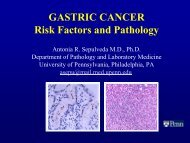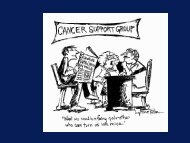Managing Side Effects of Multiple Myeloma and its Treatments
Managing Side Effects of Multiple Myeloma and its Treatments
Managing Side Effects of Multiple Myeloma and its Treatments
- No tags were found...
Create successful ePaper yourself
Turn your PDF publications into a flip-book with our unique Google optimized e-Paper software.
<strong>Multiple</strong> <strong>Myeloma</strong> :<strong>Managing</strong> <strong>Side</strong> <strong>Effects</strong>Patricia Mangan, CRNP
Clinical Presentation<strong>and</strong> Common Symptoms• Pain from bone disease is most commonpresenting symptom• Anemia <strong>and</strong> fatigue• Recurrent infection• Renal dysfunction• Hypercalcemia• Often no symptoms in the early stagesBarlogie B, et al. In: Williams Hematology. 7th ed. 2006:chap 100.Rajkumar SV, Kyle RA. Mayo Clin Proc. 2005;80:1371-1382.
Bone Disease - Pain• Accumulation <strong>of</strong> myeloma cells in bone inhib<strong>its</strong>normal bone formation• Increased osteoclast activity (bone resorption)• <strong>Multiple</strong> osteolytic lesions in bones• Supportive therapy– Physical therapy, bisphosphonates, radiation,bed rest, pain medication, kyphoplasty orvertebroplastyBarlogie B, et al. In: Williams Hematology. 7th ed. 2006:chap 100.Durie BG, et al. Hematol J. 2003;4:379-398.NCCN Clinical Practice Guidelines. www.nccn.org.
<strong>Myeloma</strong> Bone Pathology
Bisphosphonates InhibitBone Destruction• For all myeloma patientswith bone disease• Pamidronate (Aredia ® )• Zoledronic acid (Zometa ® )• Monitor for– Osteonecrosis <strong>of</strong> the jaw– Renal dysfunction– Acute phase reactionsBisphosphonates coat the surface,inhibiting bone resorptionAdapted from: Durie BGM. International <strong>Myeloma</strong> Foundation. 2006. www.myeloma.org.Durie BG, et al. Hematol J. 2003;4:379-398.NCCN Clinical Practice Guidelines. www.nccn.org.
Bisphosphonates <strong>and</strong>Osteonecrosis• Uncommon complicationcausing avascular necrosis<strong>of</strong> maxilla or m<strong>and</strong>ible• Suspect with tooth or jawpain or exposed bone• May be related to duration<strong>of</strong> therapy• 2004 IMF web-basedsurvey:– 10% incidence withzoledronic acid– 4% incidence withpamidronateDurie BG, et al. New Engl J Med. 2005;353(1):99-102.
ASCO 2007 Clinical Practice Guideline:The Role <strong>of</strong> Bisphosphonates in MM• Suggest monthly bisphosphonates for 2 y• After 2 y– Consider stopping therapy in patients withresponsive or stable disease– Further use is at the discretion <strong>of</strong> thetreating physician– Resume treatment on relapse with new onset <strong>of</strong>skeletal events• While on therapy– Excellent dental hygiene <strong>and</strong> avoidance <strong>of</strong>invasive dental proceduresASCO = American Society <strong>of</strong> Clinical Oncology; y = years.Kyle et al. J Clin Oncol. 2007;25(17):2464.
Balloon KyphoplastyTreatment for tumor-related vertebralcompression fractures (VCFs)Stabilizes the fracture <strong>and</strong> correctsspinal deformity caused by VCFsKyphon. www.kyphon.com.
Anemia <strong>and</strong> Fatigue• ↑ Malignant plasma cells in bone marrow• <strong>Myeloma</strong> cells displace marrow cell precursors• ↓ Red cell production• Fatigue associated with anemia• Supportive therapy– Treatment <strong>of</strong> myeloma; epoetin alfa(recombinant human erythropoietin) (Procrit ® )or darbepoetin alfa (Aranesp ® ); red celltransfusion if neededDurie BG, et al. Hematol J. 2003;4:379-398.NCCN Clinical Practice Guidelines. www.nccn.org.
Recurrent Infection• May have 15-fold increased risk• With increased myeloma cells, WBCproduction ↓• Normal immune role <strong>of</strong> plasma cell is lost• Supportive therapy– Antibiotics, Ig therapy– Consider pneumonia <strong>and</strong> influenza vaccines,<strong>and</strong> prophylaxis for Pneumocystis carinii,herpes zoster, fungal infectionsDurie BG, et al. Hematol J. 2003;4:379-398.<strong>Multiple</strong> <strong>Myeloma</strong> Research Foundation. 2007. www.multiplemyeloma.org.NCCN Clinical Practice Guidelines. www.nccn.org.
Renal Dysfunction• <strong>Myeloma</strong> proteins filtered by kidneys• Accumulated proteins can cause tubulardamage (Bence Jones proteins in particular)• Not all patients develop renal insufficiency• Hypercalcemia contributes to renal damage• Supportive therapy– Hydration, avoid nonsteroidal antiinflammatorydrugs (NSAIDs), avoidintravenous (IV) contrastDurie BG, et al. Hematol J. 2003;4:379-398.NCCN Clinical Practice Guidelines. www.nccn.org.
Nursing Implications forSelected Therapy-Related <strong>Side</strong> <strong>Effects</strong>Thalidomide Lenalidomide BortezomibPegylatedLiposomalDoxorubicin/BortezomibBortezomib/Melphalan/PrednisonePeripheralneuropathy√ √ √ √DVT√√More withDexMore with DexMyelosuppression√√√√√NeutropeniaNeutropenia,thrombocytopenia,anemiaThrombocytopeniaNeutropenia,thrombocytopenia,anemiaNeutropenia,thrombocytopeniaHypotension√Fatigue, weakness √ √ √ √ √Sedation√Rash √ √ √ √GI disturbance√Constipation√Constipation,diarrhea√Nausea <strong>and</strong>vomiting, diarrhea√Nausea <strong>and</strong>vomiting, diarrhea,constipation,mucositis/stomatitis√Nausea, diarrhea,constipation,vomitingGI = gastrointestinal.Doxil ® [package insert]. Ortho Biotech; revised December 2007; Revlimid ® [package insert]. Celgene; 2006; Thalomid ® [package insert].Celgene; 2007; Velcade ® [package insert]. Millennium Pharmaceuticals, Inc; 2008.
Thalidomide <strong>Side</strong> <strong>Effects</strong>Toxicity Incidence InterventionPeripheralneuropathyMild: 85%Severe: 3%-5%• Patient education/early detection• Monitor at each visit• Dose adjustment• Symptom control with pharmacologicinterventionsSomnolence Mild: 75%Severe: 5%-10%• PM dosing• Avoid concurrent meds causing drowsiness• Dose adjustmentSkin rash Mild: 45% • Moisturizing lotion; antihistamines; low-doseprednisone• Stop Thal for systemic symptomsThromboemboliccomplications(DVT/PE)Monotherapy: 1%-3%With Dex: 10%-12%• Escalate dose gradually• Anticoagulation recommended• Monitor coagulation assaysMyelosuppression(neutropenia)15%-25% • Do not initiate if ANC < 750/mm 3• If ANC < 500/mm 3 , withhold Thal untilANC > 500/mm 3 <strong>and</strong> restart at 50% lower doseGastrointestinal(constipation)Mild: 80-90%Severe: 5%• Bowel regimen (call <strong>of</strong>fice if no BM in 3 days)• Increase fluid <strong>and</strong> fiber intakeIncidences <strong>of</strong> toxicities are approximate estimates based on clinical trials in myeloma <strong>and</strong> other conditions (malignant <strong>and</strong> nonmalignant).ANC = absolute neutrophil count; BM = bowel movement; DVT = deep vein thrombosis; PE = pulmonary embolism; Ghobrial & Rajkumar. JSupport Oncol. 2003;1(3):194; Thalomid ® [package insert]. Celgene; 2007.
Lenalidomide <strong>Side</strong> <strong>Effects</strong>ToxicityAstheniaHyperglycemiaThromboembolic complications(DVT/PE)Intervention• Counsel patient• Avoid concurrent meds causing asthenia• Monitor blood sugar• Counsel patient regarding diet• Anticoagulation recommended• Monitor coagulation assaysMyelosuppression(neutropenia <strong>and</strong>thrombocytopenia)• Interrupt therapy if platelets fall to< 30,000/mcL or ANC falls to < 1,000/mcL• Resume therapy at lower or same dose on first recovery• Drop dose by 5 mg on subsequent recoveriesGastrointestinal (constipation)•Bowel regimen (call <strong>of</strong>fice if no BM in 3 days)•Increase fluid <strong>and</strong> fiber intakeIncidences <strong>of</strong> toxicities are from 2 clinical trials <strong>of</strong> multiple myeloma patients (N = 346) with lenalidomide + dexamethasone.Miceli et al. Clin J Oncol Nurs. 2008:12(3 suppl):13-20; Revlimid ® [package insert]. Celgene; 2006.
Bortezomib <strong>Side</strong> <strong>Effects</strong>ToxicityPeripheralneuropathyIncidence:Single agent vs (VMP)Overall: 37% (47%)Grade ≥ 3: 11% (13%)Intervention• Patient education/early detection• Baseline assessment <strong>and</strong> monitor at each visit• Dose adjustment• Symptom control with pharmacologic interventionsHypotension Overall: 12% (12%)Grade ≥ 3: 3% (2%)• Counsel patient• Avoid concurrent meds causing hypotensionAsthenia(fatigue, malaise,weakness)MyelosuppressionOverall: 62% (21%)Grade ≥ 3: 16% (6%)Thrombocytopenia:Overall: 38% (52%)Grade ≥ 3: 32% (37%)Neutropenia:Overall: 18% (49%)Grade ≥ 3: 14% (40%)• Counsel patient (rest, nutrition, hydration, exercise)• Avoid concurrent meds causing asthenia• Cyclical with lowest levels on Day 11 <strong>of</strong> cycle• Consistent pattern that is not cumulative• Hold if platelets < 25,000/µL <strong>and</strong> reintroduce ata 25% lower dose with recoveryDiarrhea Overall: 53% (46%)Grade ≥ 3: 8% (7%)•Bulk forming laxatives such as Metamucil ® , loperamide•with caution•Adequate fluid intakeSingle-agent incidences <strong>of</strong> toxicities are based on an integrated analyses <strong>of</strong> relapsed multiple myeloma studies (N = 1008) while VMPincidences are based on the VISTA study. Colson et al. Cancer Nurs. 2008;31:239-249; Velcade ® [package insert]. MillenniumPharmaceuticals, Inc; 2008.
Peripheral Neuropathy• Associated with multiple myeloma (found in 3%-13%<strong>of</strong> patients)– Present in ~80% <strong>of</strong> previously treated patients• Nerve root pain due to direct compression byplasmacytomas• Patient education, baseline assessment by patientinquiry, <strong>and</strong> symptom assessment at each visit is crucial• Symptom control– Vitamins/minerals (B, folic acid, E, magnesium, potassium)– Amino acids (acetyl-L-carnitine, alpha lipoic acid)– Miscellaneous (topical creams [capsaicin], tonic water)– Prescription drugs (gabapentin, pregabalin, amitriptyline,sertraline, lidocaine patch)Colson et al. Clin J Oncol Nurs. 2004;8(5):473; Kwan. Neurol Clin. 2007;25:47; Maestri et al. Tumori. 2005;91:135; Pisano et al. Clin CancerRes. 2003;9:5756; Richardson et al. J Clin Oncol. 2006;24(19):3113.
Neuropathy-Assessment ToolI have numbness or tingling in myh<strong>and</strong>sI have numbness or tingling in myfeetNot at all A little bit Somewhat Quite a bitVerymuch0 1 2 3 40 1 2 3 4I feel discomfort in my h<strong>and</strong>s 0 1 2 3 4I feel discomfort in my feet 0 1 2 3 4I have joint pain or muscle cramps 0 1 2 3 4I feel weak all over 0 1 2 3 4I have trouble hearing 0 1 2 3 4I get a ringing or buzzing in myears0 1 2 3 4I have trouble buttoning buttons 0 1 2 3 4I have trouble feeling the shape <strong>of</strong>small objects when they are in myh<strong>and</strong>0 1 2 3 4I have trouble walking 0 1 2 3 4Cella D, et al. Cancer. 2003;98:822-831.
Hematologic Management• Thalidomide—neutropenia– Do not initiate therapy with absolute neutrophil count (ANC)
Sedation <strong>and</strong> Rash• Sedation (thalidomide)– Take total dose at night– Avoid hazardous tasks– Gradual dose titration may allow for acclimation– Review concurrent contributing medications• Rash (thalidomide,lenalidomide)– Diphenhydramine, cortisone creams,acetaminophen– Discontinue thalidomide if any systemicsymptomsColson K, et al. Clin J Oncol Nurs. 2004;8:473-480; Ghobrial IM, Rajkumar SV. J Support Oncol.2003;1:194-205; Revlimid [package insert]. Summit, NJ: Celgene Corporation; 2006; Thalomid [packageinsert]. Summit, NJ: Celgene Corporation; 2006.
Herpes Zoster Eruption
Herpes Zoster/Shingles
DVT Risk Reduction withLenalidomideThromboembolic Events Among 445 PatientsEnrolled in ECOG 4A03% <strong>of</strong> Patients2018161412108642022.16.1High Dose Dex(n=223)Low Dose Dex(n=222)Rajkumar SV et al. Abstract # 8025. Presented at: ASCO Annual Meeting; June 1–5, 2007; Chicago
Patient Resources• American Cancer Society– 1-800-227-2345; www.cancer.org• Association <strong>of</strong> Cancer Online Resources– 1-212-226-5525; www.acor.org• Cancer Care, Inc.– 1-800-813-4673; www.cancercare.org• Chronic Disease Fund– 1-877-968-7233; www.cdfund.org• International <strong>Myeloma</strong> Foundation (IMF)– 1-800-452-2873; www.myeloma.org• The Leukemia & Lymphoma Society– 1-800-955-4572; www.leukemia-lymphoma.org• <strong>Multiple</strong> <strong>Myeloma</strong> Research Foundation (MMRF)– 1-203-972-1250; www.multiplemyeloma.org• National Cancer Institute– 1-800-4-CANCER; www.nci.nih.gov


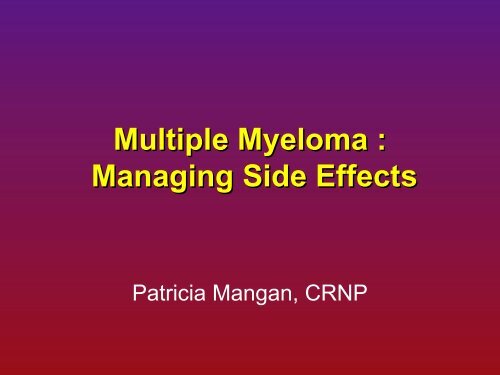

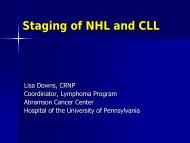

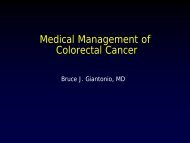

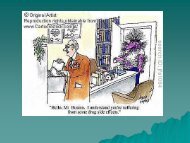
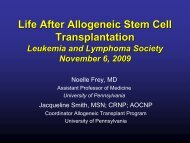
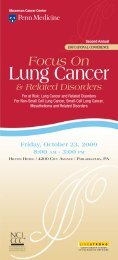


![Agenda [PDF] - Abramson Cancer Center](https://img.yumpu.com/35341208/1/190x245/agenda-pdf-abramson-cancer-center.jpg?quality=85)
